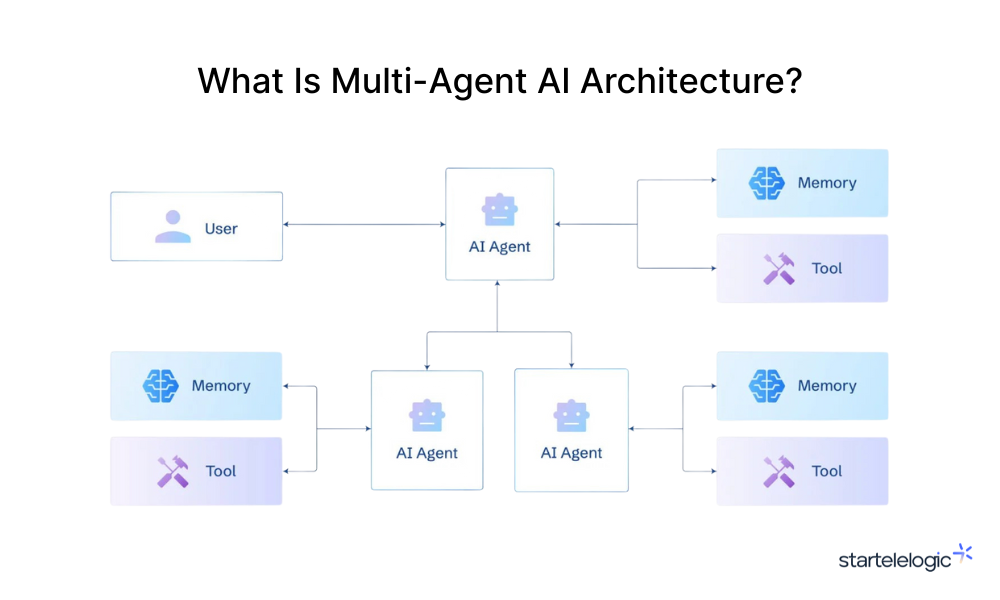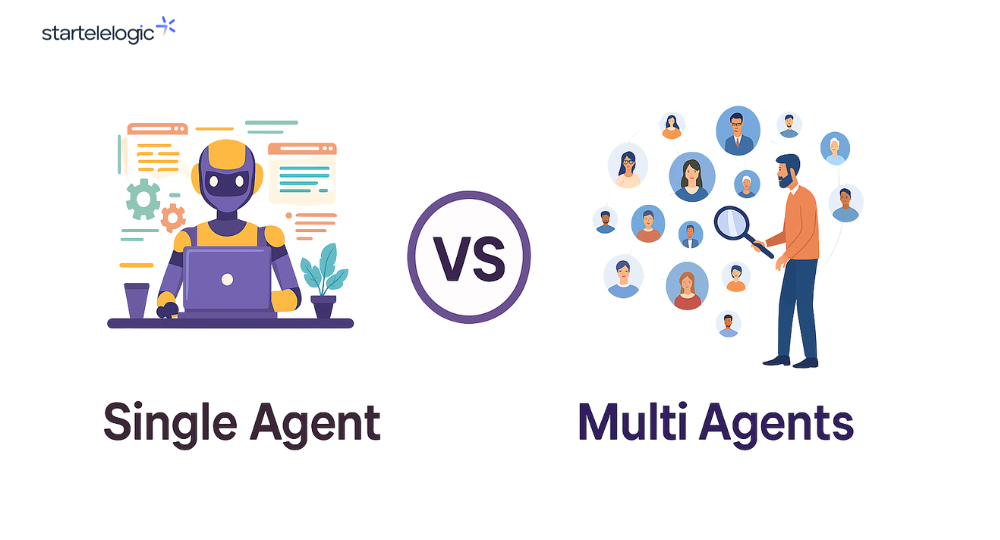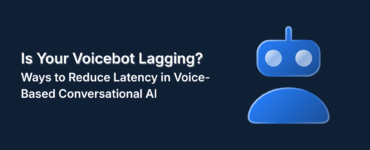AI and Customer Satisfaction are at a turning point. For the past decade, the spotlight has been on building massive, all-in-one AI models trained on enormous datasets to handle almost anything. Systems like GPT and PaLM have shown what scaling intelligence can achieve.
But scale alone isn’t enough. Studies suggest that while adoption of AI tools in businesses grew by over 250% in the last five years, customer satisfaction scores in sectors like retail and telecom have actually dropped by 10–15%. The reason? These large systems often come with high costs, limited flexibility, and poor adaptability to real-world customer needs.
That’s why attention is shifting toward Multi-Agent AI Architecture—an approach where multiple smaller, specialized agents work together, much like teams in a workplace. This model can respond faster, adapt better, and often deliver more value without the heavy costs of monolithic systems.
This isn’t just an upgrade—it’s a major shift that could define the future of AI and its impact on customers.
Why Monolithic AI Is No Longer Enough
Let’s start by addressing the elephant in the room: why move away from single, all-powerful AI models?
- Exponential Costs of Scaling
Training billion-parameter models demands staggering compute, energy, and financial resources. Only a handful of companies can afford this. Smaller players are locked out. - One-Size-Fits-All Problem
A single model trying to master reasoning, creativity, retrieval, and domain-specific tasks spreads itself thin. Depth is sacrificed for breadth. - Lack of Modularity
Updating one capability (e.g., better reasoning) means retraining or fine-tuning the entire system. This is like rebuilding a car just to change the tires. - Context Fragility
Monolithic models struggle with handling dynamic, multi-step, real-world workflows where tasks require switching between different kinds of expertise.
In other words, monolithic AI is a skyscraper with no flexibility—impressive, but rigid. Multi-agent systems, by contrast, are more like a city: diverse, scalable, and adaptive.
What is Multi-Agent AI Architecture?

A Multi-Agent AI Architecture is an ecosystem of AI components, each with its own responsibilities, capabilities, and autonomy.
Think of it like a company:
- The Manager Agent breaks down goals into tasks.
- The Specialist Agents execute specific tasks (data analysis, language processing, decision-making).
- The Coordinator Agent ensures smooth collaboration and resolves conflicts.
Together, they form a distributed intelligence system—where intelligence is not centralized in one model but emerges from interactions among many.
Core Components of Multi-Agent AI Architecture
To understand how this architecture works, let’s break down its essential components:
1. Agents
Each agent is an autonomous entity with:
- Perception capabilities (input processing)
- Internal state or memory
- Decision-making logic (rules, ML models, or LLMs)
- Action execution (output generation or task performance)
Agents can be homogeneous (same architecture) or heterogeneous (different models/types).
2. Environment
The shared space where agents interact—this could be a digital simulation, a physical robot network, or a software platform like a customer service dashboard.
3. Communication Protocols
Agents exchange information via messaging systems. Common approaches include:
- Message Passing (e.g., using JSON or XML)
- Blackboard Systems (shared memory space)
- Ontologies (structured knowledge sharing)
4. Coordination Mechanisms
To avoid chaos, agents need coordination:
- Centralized Control (a “manager” agent assigns tasks)
- Decentralized Coordination (agents self-organize using rules or auctions)
- Hybrid Models (mix of top-down and peer-to-peer)
5. Learning & Adaptation
Advanced systems incorporate reinforcement learning or federated learning, allowing agents to improve performance based on feedback and experience.
Why the Shift to Multi-Agent AI Architecture?
The move from single models to multi-agent systems isn’t just academic—it’s driven by real-world demands. Here’s why this shift matters:
1. Enhanced Problem-Solving Capacity
Complex problems often require multiple perspectives. For example, diagnosing a medical condition may involve:
- A symptom analyzer agent
- A medical literature researcher agent
- A patient history reviewer agent
- A risk assessment agent
Together, they form a diagnostic pipeline far more robust than a single model.
2. Improved Scalability and Modularity
New agents can be added or updated without overhauling the entire system. This makes Multi-Agent AI Architecture ideal for enterprise applications where requirements evolve.
3. Fault Tolerance and Resilience
If one agent fails, others can compensate or reroute tasks. This redundancy is crucial in safety-critical systems like air traffic control or autonomous fleets.
4. Specialization and Efficiency
Agents can be optimized for specific tasks—e.g., one agent handles natural language, another processes images, and a third performs numerical reasoning. This leads to faster, more accurate outcomes.
5. Dynamic Adaptation to Environments
In changing conditions—like fluctuating market trends or traffic patterns—agents can re-negotiate roles, update strategies, and respond in real time.
6. Human-Like Collaboration
Multi-agent systems mimic human teamwork. Just as a company uses departments (marketing, finance, R&D), AI agents can divide labor, consult experts, and reach consensus.
How Multi-Agent AI Architecture Differs from Traditional AI Pipelines
It’s important to distinguish Multi-Agent AI Architecture from older pipeline-based AI systems.
| Structure | Linear, sequential | Networked, dynamic |
| Control | Centralized | Decentralized or hybrid |
| Flexibility | Rigid, hard to modify | Adaptable, modular |
| Failure Impact | High (single point of failure) | Low (redundancy) |
| Communication | Minimal or none | Rich, structured messaging |
| Learning | Offline or batch | Continuous, collaborative |
In essence, Multi-Agent AI Architecture is less like an assembly line and more like a swarm intelligence system—inspired by nature, such as ant colonies or bird flocks, where simple agents achieve complex group behaviors.
The Role of Large Language Models (LLMs) in Multi-Agent Systems
Interestingly, LLMs like GPT, Claude, or Gemini are becoming the “brains” of individual agents. Instead of building rigid rule-based agents, developers now use LLMs to power agents with natural language understanding, reasoning, and communication skills.
For example:
- AutoGPT and BabyAGI are early examples of LLM-based agents that can set goals, plan steps, and execute tasks.
- Meta’s CICERO combines LLMs with game theory to play Diplomacy at a human level using strategic negotiation between agents.
- Microsoft’s TaskWeaver uses a multi-agent setup where one agent plans, another retrieves data, and another generates code.
These systems demonstrate how LLMs act as cognitive engines, enabling agents to understand context, generate responses, and collaborate—essentially turning language models into team players.
Future Trends in Multi-Agent AI Architecture
The evolution of Multi-Agent AI Architecture is accelerating. Here’s what’s on the horizon:
1. Self-Organizing Agent Societies
Agents that form teams dynamically based on task requirements, much like humans form project groups.
2. Agent Marketplaces
Platforms where pre-trained agents can be bought, sold, or rented—like an app store for AI specialists.
3. Emotional and Ethical Agents
Agents equipped with emotional intelligence and ethical reasoning to handle sensitive interactions (e.g., mental health support).
4. Cross-Domain Agent Collaboration
Agents that span industries—e.g., a healthcare agent collaborating with a financial agent to personalize insurance plans.
5. AI-Native Organizations
Entire companies run by AI agents handling HR, marketing, R&D, and operations—supervised by humans.
6. Integration with IoT and Robotics
Millions of physical devices (robots, sensors) acting as agents in a global AI network.
Why This Matters for Businesses and Developers
For organizations, adopting Multi-Agent AI Architecture is no longer optional—it’s a strategic imperative.
- Innovation: Enables smarter, more adaptive products and services.
- Efficiency: Automates complex workflows with minimal human oversight.
- Competitive Edge: Faster decision-making, better customer experiences, and reduced operational risk.
For developers, this shift means:
- Moving beyond prompt engineering to agent design and orchestration
- Learning frameworks like LangChain, AutoGen, Haystack, or Microsoft Semantic Kernel
- Focusing on agent communication protocols, task delegation, and feedback loops
Conclusion: The Future is Collaborative
The era of the lone AI genius—powerful but isolated—is giving way to a new paradigm: collaborative intelligence. Multi-Agent AI Architecture represents a leap forward in how we design, deploy, and scale artificial intelligence.
By mimicking the way humans organize into teams, societies, and ecosystems, multi-agent systems unlock levels of adaptability, resilience, and problem-solving power that single models simply cannot match.
As we stand on the brink of AI systems that can plan, reason, communicate, and act collectively, one thing is clear: the future of AI isn’t just intelligent—it’s social.
And for businesses, developers, and innovators, understanding and leveraging Multi-Agent AI Architecture isn’t just about keeping up. It’s about shaping the next generation of intelligent systems.
Frequently Asked Questions (FAQs) About Multi-Agent AI Architecture
1. What is Multi-Agent AI Architecture?
Multi-Agent AI Architecture is a system where multiple autonomous AI agents collaborate, compete, or coordinate within a shared environment to achieve complex goals. Each agent is specialized for a specific role, such as planning, reasoning, or retrieving information, and together they form a more flexible and scalable AI ecosystem.
2. How is Multi-Agent AI different from Monolithic AI?
Monolithic AI relies on a single, large model to handle all tasks, while Multi-Agent AI distributes responsibilities across specialized agents. This makes multi-agent systems more scalable, adaptive, and resilient compared to monolithic architectures, which often struggle with specialization and efficiency.
3. What are the benefits of Multi-Agent AI systems?
Key benefits include specialization, modularity, scalability, cost efficiency, robustness, and improved safety. Because agents can monitor and critique one another, multi-agent systems also reduce risks such as hallucinations and bias in outputs.
4. What industries can benefit from Multi-Agent AI Architecture?
Industries such as healthcare, finance, robotics, logistics, smart cities, and e-commerce can benefit significantly. For example, in healthcare, agents can handle diagnosis, drug discovery, and patient monitoring in coordination, leading to faster and more accurate outcomes.
5. What challenges exist in implementing Multi-Agent AI?
Challenges include coordinating agents efficiently, avoiding unpredictable emergent behaviors, addressing security vulnerabilities, and developing standardized evaluation metrics. Overcoming these requires robust orchestration frameworks and strong governance models.




